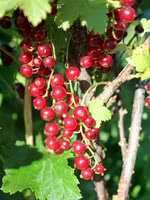Mon-Fri 9am - 5pm Mountain time
Red Currant vs Bilberry
Vaccinium myrtillus
Ribes rubrum
CUSTOM GROW
NOT AVAILABLE THIS SEASON - MIGHT RETURN
Bilberry is a native perennial shrub valued for its small, blue-black berries that ripen in mid to late summer. The berries resemble blueberries but have a richer, more tart, and intense flavor. They have long been used for fresh eating, baking, and preserves, while also providing food for birds and mammals. In spring, its delicate pinkish flowers attract bees and other pollinators.
Growing low to the ground, Bilberry forms spreading colonies that create dense understory cover. This growth habit provides food and shelter for wildlife, and its foliage adds seasonal interest by turning red to purple in autumn. With its adaptability and ecological benefits, Bilberry is well-suited for naturalization, ecological restoration, and pollinator gardens.
Red Currant is a deciduous shrub native to western Europe. It features five-lobed, maple-like leaves, and bright red berries that can be used in jams, sauces, and fresh eating.
Although this shrub is self-fertile, it will be more productive if another pollinator is present. For year over year high yields, ensure you fertilize (bone meal), prune, and mulch your Red Currant shrub.
Bilberry Quick Facts
Red Currant Quick Facts
Toxicity: leaves may be unsafe in high doses

